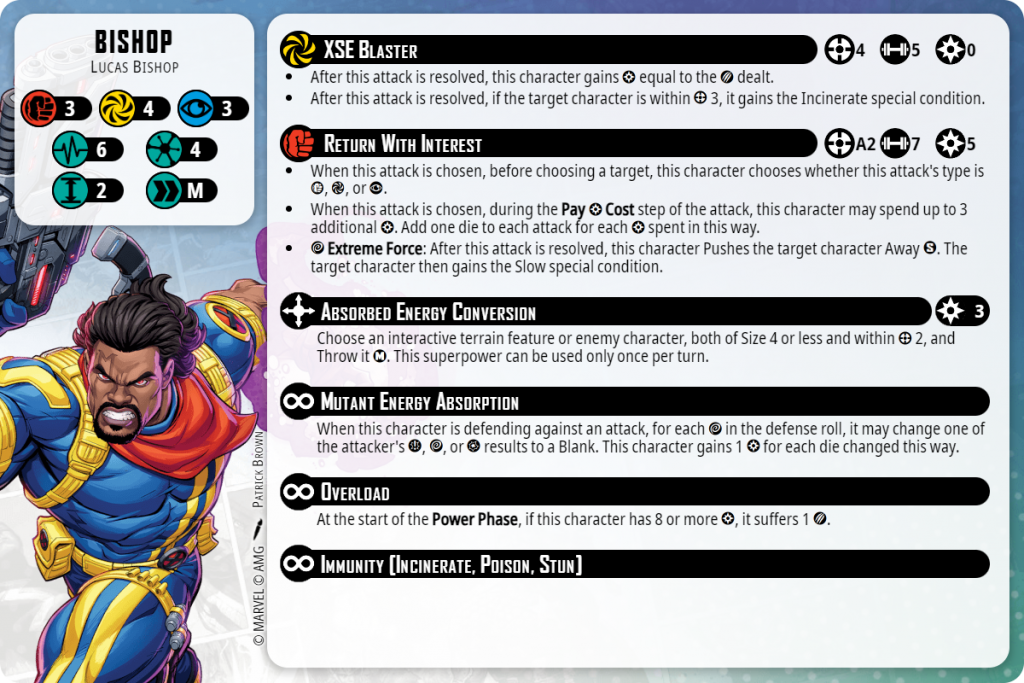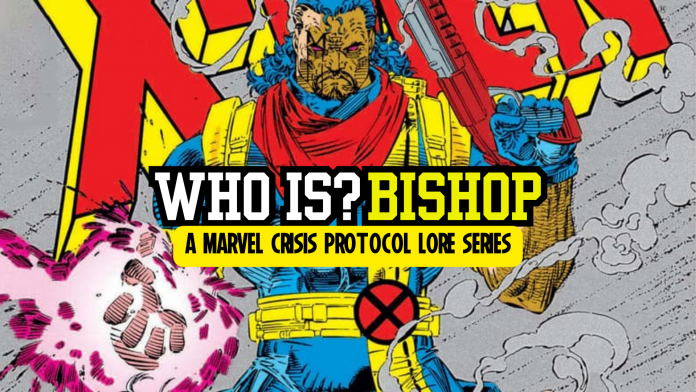Time-travel can be complicated, especially when you are trying to re-write your present by altering the events of the past. This is the most common plot thread found in the pages of Marvel Comics that feature the mutant known as Bishop (alter ego: Lucas Bishop). Bishop is one of the newest characters in Marvel Crisis Protocol by Atomic Mass Games and is part of new wave of mutants entering the game and hoping to find their way into your roster. But who is Lucas Bishop? Where did he come from? How long has he been a part of Marvel comics? Like every Who is? article, we will attempt to answer these questions and more about the wonderful characters of MCP.
Background
The first thing you need to know about Bishop is that he is a time-traveler from the future. And in his future, everything has gone wrong. He was raised in a concentration camp (yes, you read that right) for mutants that has been established after the Summers Rebellion, which was an uprising of both mutants and humans to overthrow the Sentinels, giant robots initially programmed to hunt mutants, but decided on their own to go even further (more on them in a future article). Bishop has a distinctive “M” branded over his right eye, which is how mutants are identified in his era. While chasing the criminal Fitzroy through time, Bishop encounters the X-Men who he had only heard stories and fables about in his own time. After battling alongside the X-Men, Professor Charles Xavier offered him a place in the X-Men, which Bishop accepted. In other comic runs, Bishop has been a member of the FBI and assigned to District X to solve mutant-related crime, been at odds with the X-Men (and in Civil War, turned them in to the original Sentinels organization, O*N*E), but one semi-common story line has stood out, and become very closely tied to the character, and that is his conflict with the time-travelling mutant Cable. In the very famous Messiah Complex storyline, the first mutant is born since M Day. In Bishop’s timeline, the actions of this child cause the government to place all mutants in concentration camps, and Bishop believes that if he can kill the child before it can cause this, he will change his future. This child is Hope Summers, and is under the protection of Cable. To achieve this goal, he will work with Apocalypse and Stryfe (Cable’s evil twin because of course he has one), though he will ultimately be knocked unconscious and transported to a barren future with his time-travelling technology taken from him. In the 2019 re-launch of the X-Men line (helmed by one of my favorite writers- Jonathan Hickman), Bishop is now part of the Marauders led by Kitty Pryde, and becomes the Red Bishop in the Hellfire Club.
Publication History/MCU History
Bishop was created by Whilce Portacio and John Byrne and made his debut in Uncanny X-Men #282 in November of 1991. He has had four limited-run series and was a regular in the District X series. In addition to being able to time-travel with technology from his relative present-day, Bishop has the mutant ability to absorb all types of energy and then manipulate that energy how he wants to. He can fire it in bursts of energy or store it to help him heal from damage, but he can be overloaded by what he absorbs, though nobody really knows what his upper-limit is for energy absorption. Bishop made several appearances in X-Men: The Animated Series (voiced by Philip Akin), and will be making a return in the Disney+ series X-Men ‘97 (voiced by Isaac Robinson-Smith). Bishop has not appeared in Disney’s MCU, but did appear in the FOX movie X-Men: Days of Future Past and was portrayed by Omar Sy.
Recommended Runs
–Uncanny X-Men #282 (Byrne and Portacio): This is the first appearance of BIshop in a comic, and while we don’t learn a TON about him here, I always like going back to the start of characters and seeing how they’ve changed over the years. This version of Bishop is also the inspiration for the box model from AMG.
–X-Men: Messiah Complex #1, Uncanny X-Men #492-494, X-Factor #25-27, New X-Men #45-46, X-Men #205-207 (Various writers): The entire Messiah Complex storyline is a crucial Bishop storyline that sees him hunting down Hope Summers through time to try to change his timeline.
–X-Men: The Animated Series Season 1, Episodes 11-12: These episodes are the animated series’s interpretation of the Days of Future Past storyline. It has great action, and helped to establish that the animated series was going to draw inspiration from the comics it was based on, both past and present.
Does the Model Miss the Mark?

His competitiveness notwithstanding, AMG has done another great job of translating a comic character to the game of Marvel Crisis Protocol. Bishop gains power by absorbing energy when attacked, and it increases his resilience by changing attack dice to blanks. Additionally, his ability to choose what type of attack he is doing when he uses his Return With Interest spender attack is a really good in-game representation of how BIshop can absorb all different types of energy and then redirect it back at his opponents. As a player, he probably won’t find his way into many of my squads, because I am just not a fan of being punished for having large amounts of power on a character, especially when it’s paired with attacks and superpowers that require a pretty big power investment to begin with. His Overload superpower is very accurate, but I think it’s going to keep him off a lot of tables. Have any other recommended readings for Bishop? Strategies for playing him? Let us know below!


